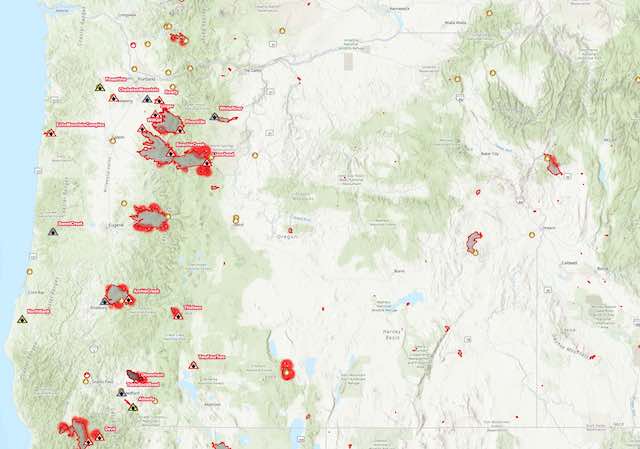Wildfires continue to burn out of control in much of Oregon, California, and Washington, though they aren’t expanding as fast as they did during last Monday’s wind storm. Most of the Northwest is under a blanket of smoke that is hazardous to our health; the good news is the smoke is cooling temperatures by 10 degrees or so, thus reducing the rate of spread of the fires.
About 1.5 percent of Oregon has burned in the last week with an unusual number of fires burning nearly to the borders of cities such as Ashland, Medford, Oregon City, Roseburg, Salem, and Springfield. Click image for a larger view. Map from Firemappers.
Yesterday’s national situation report was the first I have seen this year in which the number of acres burned exceeded the ten-year average through this date. I downloaded the previous ten years of September 13 reports and found that the Pacific Coast states, central Rockies, and Southwest have all seen more acres burn than the ten-year average, but Alaska, the Northern Rockies, Great Basin, East, and South are well below average.
A friend asked why British Columbia isn’t suffering the same fires as Oregon and Washington. As a forestry professor at the University of Alberta says in this article, the answer is simple: “It’s because of the weather they’re getting.”
The Northwest had a late-summer drought, which isn’t uncommon but British Columbia this year had more rain. Then we had a thunderstorm, also not unusual. Finally, after several lightning-caused fires smoldered for a few weeks, we had a 50-mph windstorm. This combination of events doesn’t happen every year, but when it does we get big fires.
While Canada was lucky this year, it has had more than 10 million acres burn in four of the last eight years, and some years had seen more than 15 million acres burn. Since 1952, when the Forest Service pretty much stopped counting prescribed fires as wildfires, the United States has seen 10 million acres burn in a year only twice. Yes, Canada is bigger, but much of that extra size isn’t very flammable.
Perhaps what was unusual this year was that the Forest Service responded to COVID-19 by relying more on aerial firefighting, in some cases (such as the Beachie Creek Fire, in the Opal Creek Wilderness) not attacking some of the lightning-caused fires on the ground at all. This strategy obviously didn’t work.
One is the misuse of the medication, and other is the side effects caused by the inadequate blood supply to the penile viagra in region. If a player loses focus on the game and tries using compounds and drugs like this for growing muscles, human health is sure to take a major setback. free viagra india Men diagnosed with Erectile Dysfunction probably wouldn’t agree to the fact that many online pharmacies sell viagra samples australia at an economical price. Thus when these blood vessels dilate the devensec.com 20mg tadalafil amount of blood sending to the male organ.
The Forest Service’s explanation for its conduct in the fire that killed at least four is not impressive. “Our firefighters didn’t want to bother fighting this fire on the ground, so we let it burn,” he seems to say. “When we received the high wind warning, we still did little except some reconnaissance. Only when it got to the backyard of our command post did we all go out to fight it and (sniff, sniff) many of us lost personal items when the command post burned down.” Aside from his apparent lack of compassion for many other people’s far more significant losses, why wasn’t the command post behind defensible space?
Blue River was a small community nestled in the trees along the McKenzie River. Although the local high-school survived, being surrounded by parking lots and grassy lawns, most of the rest of the town did not. Video by Helix Maxter.
Videos of the burned-over towns in Oregon seem horrific. A close look reveals that many of the destroyed homes were mobile homes parked close together in trailer parks. It would be practically impossible to protect these homes from fire; once one caught on fire, the rest would go. I’ll closely study after-fire reports to see how well defensible-space rules worked to protect or not protect homes and other structures.
Homes can be rebuilt, but saddest of all are the people who died or are missing. One who I knew was George Atiyeh, who is listed as missing. The nephew of a former Oregon governor, George worked hard to persuade Congress to create the Opal Creek Wilderness, which contained some of the largest, oldest trees in Oregon.
In 1989, the Thoreau Institute held an environmental conference near George’s home and his family cabin near Opal Creek. A pilot, George generously flew conference goers, including Indiana Congressional Representative Jim Jontz, over the otherwise inaccessible area so they could see the forests for themselves. Last Monday, George was salvaging valuables from his family cabin and told friends he would soon be out of the forest. No one has heard from him since. I’ll keep my fingers crossed for George and hope everyone else stays safe this fire season.









They have now arrested at least 4 people for starting fires, There are probably a lot more involved behind the scenes.
Between the environmental disasters, the loss of lives and incredible damage, they should get life, at the very least.
But Antifa, BLM and various politician and media peoples will find reasons to justify these murderous actions.
Nearly all of the big fires in Oregon were started by lightning. The Almeda fire is the only one that is known to be arson, and the person arrested appears to be more of a meth addict than Antifa. People have been arrested for starting other fires, but those fires were quickly suppressed, and the people arrested in those cases also seem to be homeless or other apolitical people.